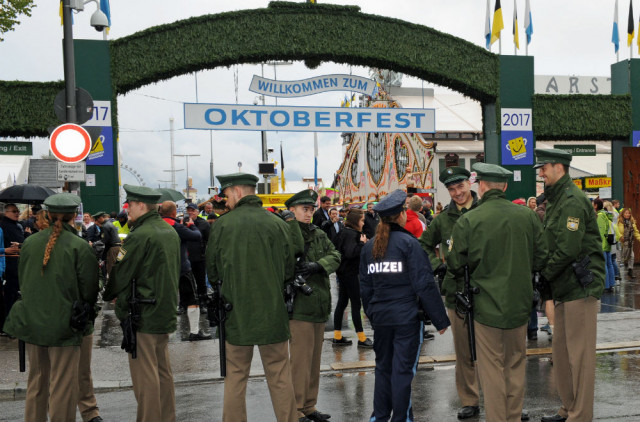What crimes are committed in Germany and where is criminality most common?

Several million crimes are committed in Germany every year. From Mecklenburg to Marburg, from Freiburg to Friesland, police have their work cut out tracking down criminals. We take a closer look at the crimes, the culprits, the victims, and where they are.
This article is available to Members of The Local. Read more Membership Exclusives here.
In 2016, the last year we have complete numbers for, close to 6.4 million crimes were registered by the police in Germany - that is roughly one crime for every twelve people who live here. The actual number of times people broke the law is higher - but for obvious reasons the police only provide information on crimes that they are aware of.
Some crimes are not reported because victims fear reprisals or because the victims do not believe that anything good will come of reporting it. Nonetheless, reported crime statistics still give interesting insights into the safety (or lack thereof) of modern-day Germany.
The good news is that reported crime has been dropping steadily over more than a decade. Whereas in 2005 slightly over 7,622 crimes were committed for every 100,000 people in Germany, that number had dropped to 7,161 in 2016.*
More worrying is a recent rise in violent crime, which includes aggravated assault, homicide and sexual assault. While violent crime dropped year-on-year from 2009 and 2014, the trend was reversed in 2015 when a 0.2 percent rise was recorded. And that reversal accelerated in 2016 when violent crime jumped a dramatic 6.7 percent. The backslide means that violent crime is about as prevalent now as it was fifteen years ago.
Meanwhile, Germany’s police haven’t really improved in the ability to catch lawbreakers. Their Aufklärungsquote (rate of solving crime) has remained more or less constant over the past 15 years, with police solving just over every second crime (56 percent). (Police statistics show suspects charged with a crime, but not the eventual result of a court case).
 Photo: DPA
Photo: DPA
The Crimes
Homicide
In 2016, the number of homicides or attempted homicides leapt 14.3 percent, with the number hitting just over 2,400.
Still though, there are far fewer murders taking place in Germany now than there were in the past. World Bank data shows that the homicide rate more than halved between 1995 and 2015 from 1.7 homicides per 100,000 people to 0.8 per 100,000.
In an international comparison, Germans are far less likely to die a violent death than Americans, as the homicide rate in the US is six times higher than in Deutschland. Over the past 20 years Germany has also had a lower homicide rate than either France or the UK.
Germany’s police are much better at solving murders than other types of crime. In fact, if you take someone else’s life your chances of getting away with it are pretty slim as the Aufklärungsquote is 95 percent.
SEE ALSO: Police solve murder of young girl found dead near Jena 27 years ago
Germans are also more likely to be murdered by someone they are related to than by a complete stranger. In 2016, 35 percent of suspects in murder cases were either a marital partner or a family member, while 27 percent of victims did not know the suspected attacker.
Sexual crimes
Sex crimes have become extremely politically sensitive in Germany in recent years, as right-wing critics of the government blame refugees and immigrants for a rise in reported rape. Mass sexual assaults in Cologne over New Year 2015/16, in which men from North Africa were often the perpetrators, were taken as evidence of this.
Police figures from 2016 show that sex crimes rose sharply in 2016, with reported incidents rising from 7,022 the previous year to 7,919. Foreign nationals were also disproportionately likely to be charged with these types of crimes, making up four in ten of the suspects in sexual assault and rape cases.
This is another type of crime in which the attacker is more likely to be known to the victim than to be a stranger. In two thirds of cases in 2016 the victim knew their attacker, in one in five cases the attacker was a family member or marital partner.
Robbery
While violent crime has been increasing in the past couple of years, the recent story on theft is much more positive.
All types of theft fell in the most recent statistics. Still, some 2.4 million cases of thievery were reported in 2016, meaning theft still makes up 40 percent of all crime.
Roughly 36,000 car owners found that their vehicle had been pinched in 2016, and 330,000 bicycles were also looted. Meanwhile over 150,000 homeowners had to deal with a break-in.
Police are much less effective at solving robberies than they are with violent crime. They only get to the bottom of one in four car thefts and one in six burglaries. And if your bike is stolen you can count yourself very lucky if you ever see it again - the cops catch less than one in eleven bike thieves.
Police point to a slight drop in overall theft since the start of this century as a positive trend. Authorities also say they have stopped the rot on break-ins. After burglaries jumped by the highest proportion in 15 years in 2015, the police started a public awareness campaign. They have created a website to inform people on how to better secure their homes, for example by installing shutters and better locking systems. The Federal Police Office (BKA) attributes a 10 percent drop in break-ins in 2016 to heightened public awareness.
Drug and weapon laws
Both drug dealing and infringements of weapons laws have risen recently. In 2016 police reported a 17 percent increase in cocaine dealing and importation, a jump that is mirrored in statistics for heroin, cannabis and amphetamines.
While infringements of weapons laws have generally dropped since 2003, there was bad news on this front in 2016, too. There was a rise in people being threatened with guns, as well as a 25 percent jump in people being injured by gun fire.
 Photo: DPA
Photo: DPA
The suspects
What about the people committing crimes in Germany? Who are they and where do they come from?
Well, it might not come as much of a surprise to learn that men are much more likely than women to be identified by police as culprits. Of the 2.4 million people who police charged with crimes in 2016, three quarters were men.
When women are charged with a crime, it is often in connection with a neglect of their duty of care to children or in credit card fraud cases.
Non-Germans are considerably over-represented in national crime figures compared to their size in the population. Whereas one in eight inhabitants of German is foreign, just under one in three people charged with crimes are non-Germans.
The Ausländer imbalance is most clear in the sphere of pickpocketing, where 75 percent of all suspects come from abroad. And while crime committed by German citizens is going down, foreigners committed 10 percent more crimes in 2016 compared to the year before.
Police statistics also reveal the role of alcohol in fuelling crime. The culprit was drunk in 10 percent of all crime in 2016 and an astonishing one in four cases of violent crime.
People are most likely to commit crimes between the ages of 20 and 30 - one fifth of all suspects were in this age range.
A surprisingly high number of criminals are under the age of 14, the legal age of culpability in Germany. Some 56,000 children under 14 were found by police to be guilty of a crime in 2016, some 704 of whom were under the age of six. Minors were most likely to be caught shoplifting (44 percent of all crimes), but a quarter of all cases were bodily harm.
 A female defendant. Photo: DPA
A female defendant. Photo: DPA
The victims
Just as men are more likely than women to commit crime, they are also more prone to be its victims. And just as foreigners are more likely than Germans to be charged with crime, they are also more likely to have crime befall them.
Close to a million people were victims of crime in 2016, with 60 percent of them being men. But the proportion varies widely according to the crime. 93 percent of the victims of sex crimes are women but only a third of the victims of homicide or attempted homicide are female. Men are also much more likely than women to report having their stuff stolen - two thirds of the victims of theft are male.
Police statistics also make worrying reading for people in their 30s, the decade of your life when you are most likely to be a victim of all major crime including murder, physical assault, and crimes against personal liberty.
Teenagers are drastically over-represented as victims of sex crime - a quarter of all sex crimes happen to juveniles, whereas for crime in general they are victims in 8 percent of cases.
Non-Germans are disproportionately likely to commit crime, but they are also unusually likely to be its victim. Over one in five of the victims of crime in 2016 were not German. This imbalance was particularly stark in violent crime, with almost one in three victims not holding a German passport.
Where does crime happen?
Police warn that a variety of factors make it difficult to compare actual crime rates from district to district. These factors include the higher likelihood of people in the countryside to report crime, and the higher prevalence of certain crimes in districts with international borders.
Taking the police statistics at face value though, it still seems clear that criminality is focused around the big cities.
Berlin is undoubtedly the crime capital of the country. 15,700 crimes were reported for every 100,000 inhabitants of the capital in 2016, making it the city with the highest crime rate nationwide.
The capital’s police were also the worst at solving crimes in 2016, with a success rate of just 40.5 percent (compared to a national average of 56 percent.)
Hanover is the second most crime-ridden city in Germany (15,080 crimes per 100,000 inhabitants), followed by Leipzig in third (14,787).
 Police in Munich last year. Photo: DPA
Police in Munich last year. Photo: DPA
At the other end of the scale is the leafy Bavarian capital of Munich, which is by quite some way Germany’s safest city. It has a crime rate less than half Berlin’s, while its police are also second best in the country at finding criminals. With an Aufklärungsquote of 68.23 percent they are only beaten by their Bavarian neighbours in Augsburg, who solve 69.9 percent of crime.
Generally, there is less reported crime in the south of the country than there is in the north. Besides Germany's safest state Bavaria, Baden-Württemberg and Hesse both also have low crime rates.
*In 2016 several hundred thousand refugees were recorded as breaking German border crossing laws when they arrived in the country. For this reason, the Federal Criminal Police (BKA) gives crime figures with and without illegal border crossings. We base our report on figures not including illegal border crossings.
Comments
See Also
This article is available to Members of The Local. Read more Membership Exclusives here.
In 2016, the last year we have complete numbers for, close to 6.4 million crimes were registered by the police in Germany - that is roughly one crime for every twelve people who live here. The actual number of times people broke the law is higher - but for obvious reasons the police only provide information on crimes that they are aware of.
Some crimes are not reported because victims fear reprisals or because the victims do not believe that anything good will come of reporting it. Nonetheless, reported crime statistics still give interesting insights into the safety (or lack thereof) of modern-day Germany.
The good news is that reported crime has been dropping steadily over more than a decade. Whereas in 2005 slightly over 7,622 crimes were committed for every 100,000 people in Germany, that number had dropped to 7,161 in 2016.*
More worrying is a recent rise in violent crime, which includes aggravated assault, homicide and sexual assault. While violent crime dropped year-on-year from 2009 and 2014, the trend was reversed in 2015 when a 0.2 percent rise was recorded. And that reversal accelerated in 2016 when violent crime jumped a dramatic 6.7 percent. The backslide means that violent crime is about as prevalent now as it was fifteen years ago.
Meanwhile, Germany’s police haven’t really improved in the ability to catch lawbreakers. Their Aufklärungsquote (rate of solving crime) has remained more or less constant over the past 15 years, with police solving just over every second crime (56 percent). (Police statistics show suspects charged with a crime, but not the eventual result of a court case).
 Photo: DPA
Photo: DPA
The Crimes
Homicide
In 2016, the number of homicides or attempted homicides leapt 14.3 percent, with the number hitting just over 2,400.
Still though, there are far fewer murders taking place in Germany now than there were in the past. World Bank data shows that the homicide rate more than halved between 1995 and 2015 from 1.7 homicides per 100,000 people to 0.8 per 100,000.
In an international comparison, Germans are far less likely to die a violent death than Americans, as the homicide rate in the US is six times higher than in Deutschland. Over the past 20 years Germany has also had a lower homicide rate than either France or the UK.
Germany’s police are much better at solving murders than other types of crime. In fact, if you take someone else’s life your chances of getting away with it are pretty slim as the Aufklärungsquote is 95 percent.
SEE ALSO: Police solve murder of young girl found dead near Jena 27 years ago
Germans are also more likely to be murdered by someone they are related to than by a complete stranger. In 2016, 35 percent of suspects in murder cases were either a marital partner or a family member, while 27 percent of victims did not know the suspected attacker.
Sexual crimes
Sex crimes have become extremely politically sensitive in Germany in recent years, as right-wing critics of the government blame refugees and immigrants for a rise in reported rape. Mass sexual assaults in Cologne over New Year 2015/16, in which men from North Africa were often the perpetrators, were taken as evidence of this.
Police figures from 2016 show that sex crimes rose sharply in 2016, with reported incidents rising from 7,022 the previous year to 7,919. Foreign nationals were also disproportionately likely to be charged with these types of crimes, making up four in ten of the suspects in sexual assault and rape cases.
This is another type of crime in which the attacker is more likely to be known to the victim than to be a stranger. In two thirds of cases in 2016 the victim knew their attacker, in one in five cases the attacker was a family member or marital partner.
Robbery
While violent crime has been increasing in the past couple of years, the recent story on theft is much more positive.
All types of theft fell in the most recent statistics. Still, some 2.4 million cases of thievery were reported in 2016, meaning theft still makes up 40 percent of all crime.
Roughly 36,000 car owners found that their vehicle had been pinched in 2016, and 330,000 bicycles were also looted. Meanwhile over 150,000 homeowners had to deal with a break-in.
Police are much less effective at solving robberies than they are with violent crime. They only get to the bottom of one in four car thefts and one in six burglaries. And if your bike is stolen you can count yourself very lucky if you ever see it again - the cops catch less than one in eleven bike thieves.
Police point to a slight drop in overall theft since the start of this century as a positive trend. Authorities also say they have stopped the rot on break-ins. After burglaries jumped by the highest proportion in 15 years in 2015, the police started a public awareness campaign. They have created a website to inform people on how to better secure their homes, for example by installing shutters and better locking systems. The Federal Police Office (BKA) attributes a 10 percent drop in break-ins in 2016 to heightened public awareness.
Drug and weapon laws
Both drug dealing and infringements of weapons laws have risen recently. In 2016 police reported a 17 percent increase in cocaine dealing and importation, a jump that is mirrored in statistics for heroin, cannabis and amphetamines.
While infringements of weapons laws have generally dropped since 2003, there was bad news on this front in 2016, too. There was a rise in people being threatened with guns, as well as a 25 percent jump in people being injured by gun fire.
 Photo: DPA
Photo: DPA
The suspects
What about the people committing crimes in Germany? Who are they and where do they come from?
Well, it might not come as much of a surprise to learn that men are much more likely than women to be identified by police as culprits. Of the 2.4 million people who police charged with crimes in 2016, three quarters were men.
When women are charged with a crime, it is often in connection with a neglect of their duty of care to children or in credit card fraud cases.
Non-Germans are considerably over-represented in national crime figures compared to their size in the population. Whereas one in eight inhabitants of German is foreign, just under one in three people charged with crimes are non-Germans.
The Ausländer imbalance is most clear in the sphere of pickpocketing, where 75 percent of all suspects come from abroad. And while crime committed by German citizens is going down, foreigners committed 10 percent more crimes in 2016 compared to the year before.
Police statistics also reveal the role of alcohol in fuelling crime. The culprit was drunk in 10 percent of all crime in 2016 and an astonishing one in four cases of violent crime.
People are most likely to commit crimes between the ages of 20 and 30 - one fifth of all suspects were in this age range.
A surprisingly high number of criminals are under the age of 14, the legal age of culpability in Germany. Some 56,000 children under 14 were found by police to be guilty of a crime in 2016, some 704 of whom were under the age of six. Minors were most likely to be caught shoplifting (44 percent of all crimes), but a quarter of all cases were bodily harm.
 A female defendant. Photo: DPA
A female defendant. Photo: DPA
The victims
Just as men are more likely than women to commit crime, they are also more prone to be its victims. And just as foreigners are more likely than Germans to be charged with crime, they are also more likely to have crime befall them.
Close to a million people were victims of crime in 2016, with 60 percent of them being men. But the proportion varies widely according to the crime. 93 percent of the victims of sex crimes are women but only a third of the victims of homicide or attempted homicide are female. Men are also much more likely than women to report having their stuff stolen - two thirds of the victims of theft are male.
Police statistics also make worrying reading for people in their 30s, the decade of your life when you are most likely to be a victim of all major crime including murder, physical assault, and crimes against personal liberty.
Teenagers are drastically over-represented as victims of sex crime - a quarter of all sex crimes happen to juveniles, whereas for crime in general they are victims in 8 percent of cases.
Non-Germans are disproportionately likely to commit crime, but they are also unusually likely to be its victim. Over one in five of the victims of crime in 2016 were not German. This imbalance was particularly stark in violent crime, with almost one in three victims not holding a German passport.
Where does crime happen?
Police warn that a variety of factors make it difficult to compare actual crime rates from district to district. These factors include the higher likelihood of people in the countryside to report crime, and the higher prevalence of certain crimes in districts with international borders.
Taking the police statistics at face value though, it still seems clear that criminality is focused around the big cities.
Berlin is undoubtedly the crime capital of the country. 15,700 crimes were reported for every 100,000 inhabitants of the capital in 2016, making it the city with the highest crime rate nationwide.
The capital’s police were also the worst at solving crimes in 2016, with a success rate of just 40.5 percent (compared to a national average of 56 percent.)
Hanover is the second most crime-ridden city in Germany (15,080 crimes per 100,000 inhabitants), followed by Leipzig in third (14,787).
 Police in Munich last year. Photo: DPA
Police in Munich last year. Photo: DPA
At the other end of the scale is the leafy Bavarian capital of Munich, which is by quite some way Germany’s safest city. It has a crime rate less than half Berlin’s, while its police are also second best in the country at finding criminals. With an Aufklärungsquote of 68.23 percent they are only beaten by their Bavarian neighbours in Augsburg, who solve 69.9 percent of crime.
Generally, there is less reported crime in the south of the country than there is in the north. Besides Germany's safest state Bavaria, Baden-Württemberg and Hesse both also have low crime rates.
*In 2016 several hundred thousand refugees were recorded as breaking German border crossing laws when they arrived in the country. For this reason, the Federal Criminal Police (BKA) gives crime figures with and without illegal border crossings. We base our report on figures not including illegal border crossings.
Join the conversation in our comments section below. Share your own views and experience and if you have a question or suggestion for our journalists then email us at [email protected].
Please keep comments civil, constructive and on topic – and make sure to read our terms of use before getting involved.
Please log in here to leave a comment.